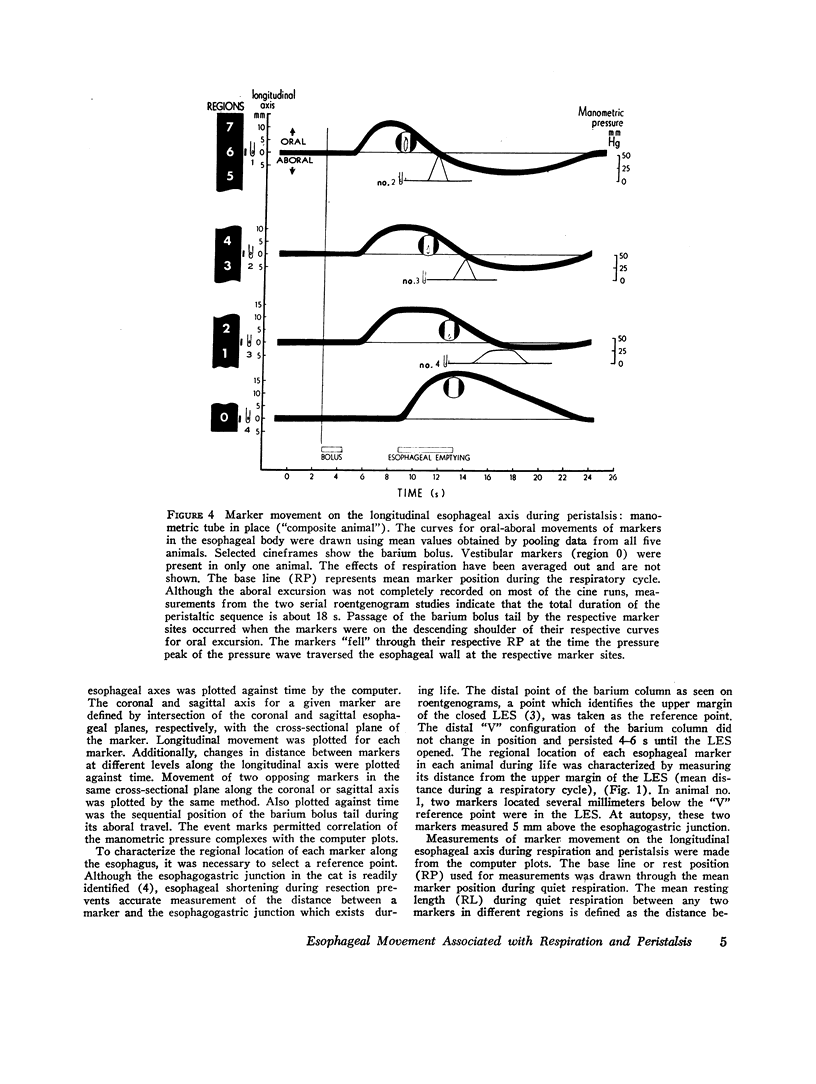Abstract
The outer, lateral esophageal walls in the distal half of the esophagus in each of five cats were labeled with small tantalum wires. About 8 wk later, esophageal motion associated with respiration and peristalsis, induced by injecting barium boli (5 ml each) into the proximal esophagus, was recorded on cine and serial biplane roentgenograms while recording intraluminal esophageal pressures simultaneously by manometry. Esophageal motion was also evaluated without a manometric tube in place. The coordinates for each marker were digitized and a computer was used to plot marker position against time. During respiration, the markers passively made a shallow, 2-10 mm excursion on the longitudinal esophageal axis. This movement was synchronous with thoracic and diaphragmatic movement and changes in intraluminal esophageal pressure. Immediately after the onset of peristalsis, the markers made a pronounced oral movement of 10 mm or more above their mean respiratory position, as if to engulf the bolus. Markers in opposing esophageal walls approximated one another and commenced an aboral movement as the bolus tail, which was essentially co-incident with onset of the manometric pressure complex, passed the marker sites. The markers returned to their respective rest positions essentially coincident with passage of the pressure complex peak and then moved below their respective rest positions. The aboral excursion occurred predominantly after the bolus had emptied into the stomach. The magnitude and duration of oral excursion was significantly greater for the distal than for the more proximal markers; conversely, the magnitude and duration of aboral excursion was greater for the proximal than for the more distal markers. During the peristaltic sequence, the labeled portion of the esophagus shortened from 26 to 46% of its resting length. No evidence of esophageal torque was shown. These findings suggest that both the longitudinal and circular esophageal musculature play an active and important role during peristaltic transport of a bolus through the esophagus.
Full text
PDF












Selected References
These references are in PubMed. This may not be the complete list of references from this article.
- Bremner C. G., Shorter R. G., Ellis F. H., Jr Anatomy of feline esophagus with special reference to its muscular wall and phrenoesophageal membrane. J Surg Res. 1970 Jul;10(7):327–331. doi: 10.1016/0022-4804(70)90051-x. [DOI] [PubMed] [Google Scholar]
- Christensen J., Lund G. F. Esophageal responses to distension and electrical stimulation. J Clin Invest. 1969 Feb;48(2):408–419. doi: 10.1172/JCI105998. [DOI] [PMC free article] [PubMed] [Google Scholar]
- Dodds W. J., Stewart E. T., McCarthy L. J., Zboralske F. F. Esophageal labeling with small tantalum wires: effects on motility and histology. Invest Radiol. 1971 May-Jun;6(3):191–198. doi: 10.1097/00004424-197106030-00005. [DOI] [PubMed] [Google Scholar]
- Hellemans J., Vantrappen G., Valembois P., Janssens J., Vandenbroucke J. Electrical activity of striated and smooth muscle of the esophagus. Am J Dig Dis. 1968 Apr;13(4):320–334. doi: 10.1007/BF02233007. [DOI] [PubMed] [Google Scholar]
- Johnson H. D. Active and passive opening of the cardia and its relation to the pathogenesis of hiatus hernia. Gut. 1966 Aug;7(4):392–401. doi: 10.1136/gut.7.4.392. [DOI] [PMC free article] [PubMed] [Google Scholar]
- Johnson H. D., Laws J. W. The cardia in swallowing, eructation, and vomiting. Lancet. 1966 Dec 10;2(7476):1268–1273. [PubMed] [Google Scholar]
- NAUTA J. The closing mechanism between the oesophagus and the stomach. Gastroenterologia. 1956;86(3):219–232. doi: 10.1159/000200561. [DOI] [PubMed] [Google Scholar]
- Stewart E. T., Dodds W. J. Making the feline esophagus with small tantalum wires. An experimental technic. Radiology. 1969 Jul;93(1):176–177. doi: 10.1148/23.1.176. [DOI] [PubMed] [Google Scholar]
- TORRANCE H. B. Studies on the mechanism of gastro-oesophageal regurgitation. J R Coll Surg Edinb. 1958 Sep;4(1):54–62. [PubMed] [Google Scholar]
- Winship D. H., Zboralske F. F. The esophageal propulsive force: esophageal response to acute obstruction. J Clin Invest. 1967 Sep;46(9):1391–1401. doi: 10.1172/JCI105631. [DOI] [PMC free article] [PubMed] [Google Scholar]
- Zboralske F. F., Dodds W. J. Roentgenographic diagnosis of primary disorders of esophageal motility. Radiol Clin North Am. 1969 Apr;7(1):147–162. [PubMed] [Google Scholar]


